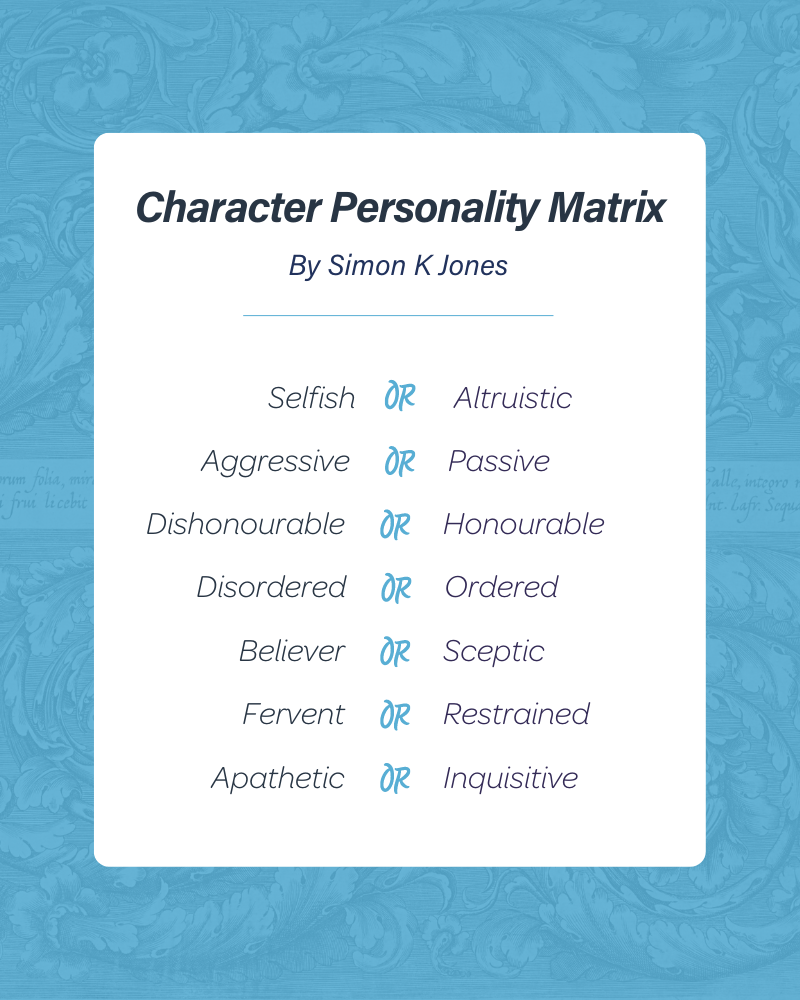Writing
A Foolproof Character Cheat Sheet (With Downloadable Template)
Writers know that characters are one of the most important things for a story to be successful. But without fully developed, believable characters, the entire story will feel flat and lifeless. A character cheat sheet can help in the early stages of character development and ensure you write well-rounded characters every time.
Why you need a character profile
A character profile is a detailed overview of your character and their life. It is a thorough description of your character, including their history, traits, appearance, and any particulars of their personality, relationships, and behaviours.
The reason why this is so important is that having more information will generate more ideas for plot points, scenes, and interactions between characters.
Most of what you put into a character profile will never make it into your finished manuscript, but knowing your characters inside out will inform the way you write. Knowing how someone will react in a certain situation ahead of time will help you get the most out of your writing time and make it so much easier to create a believable and immersive story world.
Determine the type of character you’re creating
Your story will have a variety of different characters, each with their own distinct personality and role. But before you create your characters, it’s important to first determine the type of character you’re writing. While every story is different and unique, there are a few common roles your characters will play:
- Protagonist: your main character, and the primary driver of narrative events.
- Antagonist: an opposing force who stands in the way of your protagonist achieving success.
- Anti-hero: someone who possesses qualities that make them morally ambiguous or questionable; they may do things society frowns upon but still help move the plot forward.
- Confidante: someone who provides counsel and guidance during times of trouble; they are often privy to information that is unknown by others within the story.
- Foil: someone who serves to highlight the qualities of your protagonist by possessing opposite or contrasting traits. This character serves to aid or subvert the protagonist’s aims.
- Love Interest: a character who serves as the protagonist’s goal or the reward they receive at the end of the story.
None of these types needs to be binary, and you can play with different roles for your characters. So long as you clearly define what role or combination you’d like them to play going in, you’ll be able to build something truly unique.
You might also like to consider how character archetypes fit into this framework and experiment with how those archetypes might affect the development of the role you want them to play.

Cover the basics
Covering the basics may seem like an obvious thing to do—after all, you’re writing a story, so you want people to visualise your characters in their mind’s eye—but this step is often overlooked. The result is inconsistent character descriptions or a complete lack of them in the narrative.
You can start by listing the basic information about your character: name, age, place of birth, where they live, their nationality/ethnicity/race/religion/etc., all the way down to education level (if applicable), occupation(s), and marital status.
Go into as much detail about their appearance as possible; i.e., height and build type, eye colour(s), hair colour(s), its length/style/texture, face shape, mode of dress including accessories, whether their social standing affects the way they present themselves publicly, hidden or visible disabilities or chronic illnesses, scars, or other notable physical characteristics like tattoos and birthmarks.
Give them personalities
Now it’s time to discover who your character truly is.
This is where you’ll describe how they express themselves, their likes, and dislikes. Really try to get a handle on the kind of person they are.
I discovered a handy matrix from writer Simon K Jones that I now use as a basis for developing each of my character’s personalities.

For each row, choose one of two options. There’s room for a range of responses within those choices.
You can make some interesting choices that seemingly contradict each other. For instance, someone could be both honourable and selfish. Or someone could be altruistic and apathetic at the same time.
This helps you get to know a character quickly and easily so that you and your readers can relate to them, while simultaneously giving them some interesting depth.
Once you have this fleshed out, you can also look at their relationships with others like family, co-workers, and friends (if any). A character’s personality will change how readers react to them, so it’s important you make sure this fits into your story world.
Determine their goal or motivation
This section may be the shortest, but it’s likely to be one of the most difficult. Your character has several goals and motivations, but one will stand above all others in terms of importance. You want to make sure that this is the main motivation for your protagonist—and if it isn’t, think about how you can make it so!
Once you know what that goal is, write down why they want it so badly. What drives them? What are their dreams and aspirations? But make sure you flesh out all their other goals too. This will help you discover conflicts, and also see how varying goals might feed into each other and help with world-building, even if they never end up in the finished manuscript.

Delve into their psyche
The first step in creating a character is to get to know them. A character’s history will have shaped who they are as a person, so it’s important to explore their past, childhood, and the events that made them who they are.
Outline their opinions, and how they developed. How do they emotionally respond to events? What drives their decision-making? What does true happiness look like to them? Why do they act the way they do? Knowing their psychology and the inner workings of who they are, creates a consistency that will bleed into your writing as you tackle your first draft.
How to use your character cheat sheet
All of the questions I’ve listed in the steps above will get you off to a good start. But, each section can be developed and fleshed out even more. The deeper you dig into your character, the better.
This downloadable character cheat sheet gives a list of questions for you to answer about your character. Fill out as many as you can. Import it directly into the notes section of your Novlr project to edit and develop for easy reference as you write.
Also included in the cheat sheet is The Proust Questionnaire — a set of questions answered by the French writer Marcel Proust as part of a parlour game of his day called a “confession album.”
These questions are still used by interviewers to this day and can be a great way to really get to know your characters. After you’ve built out your character profile, answer these questions from the point of view of that character as a final step to make sure you’ve really connected with them.
There you have it: a foolproof character cheat sheet that will make your characters come to life. Make sure you download the template for easy use, then fill it in to get started. You’ll be writing characters with depth, purpose, and personality in no time!